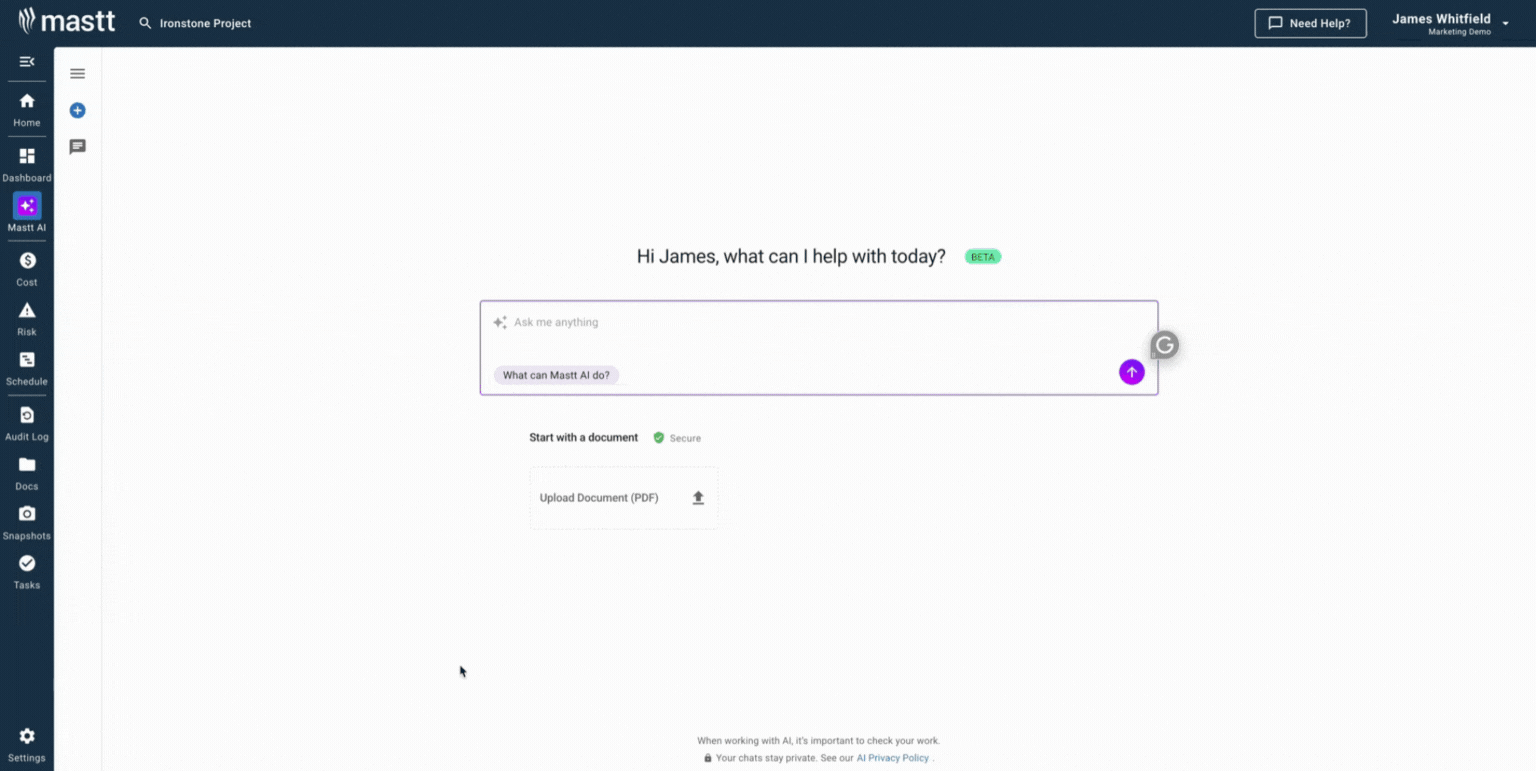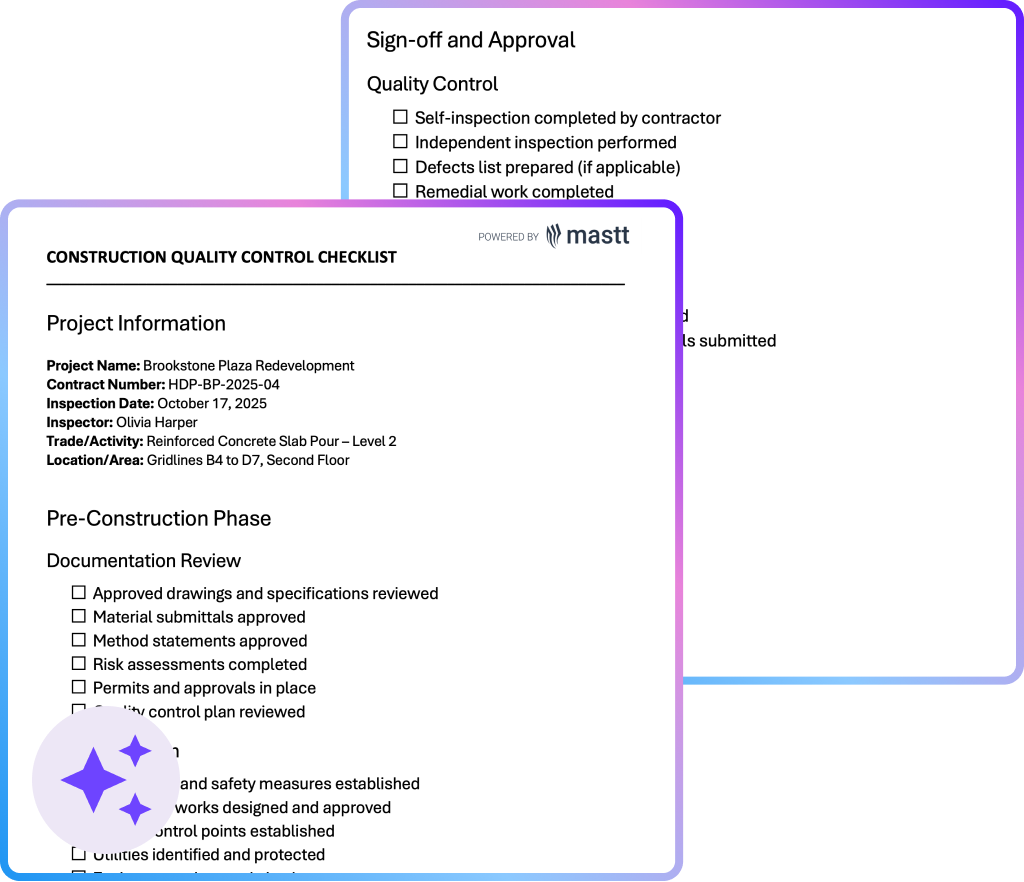What is a Construction Quality Control Checklist?
A construction quality control checklist is a standardized inspection form that verifies workmanship, materials, and compliance at specific project stages. It lists critical inspection points that must be reviewed, documented, and approved before work progresses to the next phase.
Quality control checklists create consistent inspection standards across trades and project phases. They provide inspectors with clear acceptance criteria, tolerance levels, and documentation requirements that align with contract specifications and building codes. Each checklist captures what was inspected, who performed the inspection, and whether work meets required standards.
What's Does a Construction Quality Control Checklist Template Include?
A construction quality control checklist template contains inspection criteria, verification fields, deficiency tracking sections, and approval sign-offs. Templates typically include 15-25 inspection line items with specific acceptance criteria, measurement fields, and photo documentation areas.
Essential components in a template for construction quality control checklists include:
- Project identification details: Job name, location, contract number, and inspection date for tracking and audit purposes.
- Inspection scope description: Specific work elements being inspected, such as concrete placement, structural steel connections, or MEP rough-ins.
- Acceptance criteria and tolerances: Measurable standards work must meet, drawn from specifications, AIA contract documents, or IBC requirements.
- Material verification fields: Documentation that materials meet specified grades, certifications, or test results per ASTM standards.
- Workmanship inspection points: Visual checks for proper installation, alignment, fastening methods, and finish quality.
- Compliance checkboxes: Confirmation that work meets OSHA safety requirements, local codes, and environmental regulations.
- Deficiency documentation section: Space to record non-conforming work, required corrections, and responsible parties.
- Sign-off and approval fields: Inspector signature, contractor acknowledgment, and date confirming inspection completion.
💡 Pro Tip: Reference specific specification sections in your checklist items. Instead of "check concrete strength," write "verify concrete achieves 3,000 PSI per Section 03300." This eliminates inspector confusion and ensures consistent acceptance criteria.
Why Use Templates for Construction Quality Control Checklists?
Using a quality control checklist templates for construction ensure every inspection follows the same rigorous standards regardless of inspector or project phase. Standardization reduces the inconsistency that leads to missed defects and costly rework downstream.
A checklist for quality control in construction delivers measurable improvements:
- Earlier defect identification: Catches non-conforming work before it's covered or built upon, eliminating expensive demolition and rework.
- Reduced rework costs: Systematic inspections catch defects early, preventing schedule delays and budget overruns.
- Consistent documentation: Creates defensible records for owner acceptance, regulatory approvals, and warranty claims.
- Faster issue resolution: Structured deficiency tracking ensures problems get assigned, monitored, and closed systematically.
- Improved subcontractor accountability: Clear acceptance criteria eliminate disputes about what constitutes acceptable work.
- Better regulatory compliance: Ensures OSHA, IBC, and local code requirements are verified at required hold points.
- Streamlined final inspections: Comprehensive QC records speed building department approvals and certificate of occupancy issuance.
- Stronger quality culture: Visible inspection processes signal that quality matters, improving overall workmanship across trades.
Without standardized checklists, one inspector might verify bolt torque values while another only checks bolt presence. Templates eliminate this inconsistency by ensuring every inspector evaluates the same criteria using identical acceptance standards.
How to Use a Quality Control Checklist for Construction?
Use the checklist by working through each inspection item systematically during field reviews. Mark pass/fail status. Record measurements and document deficiencies with photos. Training inspectors and customizing templates to your specifications ensures effective deployment throughout the project lifecycle.
Follow these steps to maximize checklist effectiveness:
- Customize for project specifications: Adapt generic checklists to match your contract documents, submittal approvals, and local code requirements.
- Define inspection triggers: Establish when inspections occur, such as before concrete pours, after rough-in completion, or at specified project milestones.
- Train inspectors on criteria: Ensure everyone understands acceptance standards, tolerance limits, and how to document deficiencies consistently.
- Conduct inspections at hold points: Complete required inspections before work proceeds. Never inspect after the fact when corrections become costly.
- Document findings thoroughly: Record what was inspected, measurements taken, pass/fail status, and deficiency photos with location references.
- Issue deficiency notices immediately: Communicate non-conforming work to responsible contractors the same day. Delays compound problems.
- Track corrective actions: Monitor deficiency resolution using unique reference numbers. Verify repairs before closing inspection items.
- Maintain inspection records: File completed checklists by date, trade, or project phase for owner turnover and warranty documentation.
- Analyze trends regularly: Review deficiency patterns monthly to identify recurring quality issues requiring process improvements or additional training.
💡 Pro Tip: Complete checklists immediately during the inspection, not hours later back in the office. Memory fades fast, and details like crack widths, surface conditions, or exact locations get fuzzy. Real-time documentation is always more accurate and defensible.
Create Professional Quality Control Checklists with Mastt AI
Building quality control checklists from scratch wastes time you could spend managing actual inspections. Mastt AI generates customized inspection checklists in seconds, structured specifically for your project type and quality requirements.
Here's what Mastt AI delivers for quality control documentation:
🚀 Generate complete checklists instantly: Create structured inspection forms covering foundations, framing, MEP, finishes, or any construction phase.
📂 Customize for your specifications: Tailor inspection criteria to match your contract requirements, building codes, and acceptance standards.
📑 Export in multiple formats: Download as Excel for collaborative editing or Word for formal documentation, then convert to PDF for field use.
⚡ Add project-specific details (Optional): Upload specifications or inspection and test plans, and AI extracts relevant inspection points automatically.
🎯 Refine through conversation: Adjust tolerance levels, add inspection criteria, or modify formats until the checklist matches your QC program exactly.
Mastt AI applies construction industry knowledge to recommend appropriate inspection points for each work type and project phase.
Here's how to create quality checklists with Mastt AI:
- Describe your inspection needs: Request something like "create a concrete placement quality control checklist" or "generate structural steel inspection checklist".
- Refine with AI assistance: Add specific acceptance criteria, reference standards, or modify inspection sequences through natural conversation.
- Export and distribute: Download your finished quality control checklist for construction ready for inspector training and field deployment.
Every conversation remains private and secure in your Mastt workspace. You control how checklists are created, customized, and shared across your team.
👉 Learn more in the Mastt Help Center and start creating professional quality control checklists today.

Who Should Use Construction QC Checklists?
A construction project quality control checklist template serves anyone responsible for verifying, documenting, or approving work quality throughout project delivery. It provides structured inspection protocols that keep quality standards consistent across teams and trades.
✅ Quality Control Managers: Implement standardized QC programs and audit inspector compliance with specified acceptance criteria and inspection and test plans.
✅ Project Managers: Track quality metrics, monitor deficiency trends, and ensure inspection schedules align with critical path activities.
✅ Construction Managers: Coordinate inspections across multiple trades and verify subcontractors complete self-inspections before formal reviews.
✅ Site Superintendents: Conduct daily quality walks using checklists to catch problems early and maintain workmanship standards in the field.
✅ General Contractors: Demonstrate quality compliance to owners and create audit-ready documentation for regulatory approvals.
✅ Subcontractors: Perform internal quality checks before contractor inspections to reduce callbacks and maintain reputation for quality work.
✅ Field Engineers: Document inspection results, track open deficiencies, and manage corrective action closeout through punch list completion.
✅ Owner's Representatives: Verify contractor quality processes protect owner interests and meet contract specification requirements.
When to Use a Checklist for Quality Control in Construction?
A quality control checklist for construction should be deployed at specific inspection trigger points where work verification prevents future defects or compliance issues. Timing matters because late inspections can't correct work that's already covered or built upon.
Use quality checklists at these critical project moments:
- Pre-pour inspections: Verify formwork, rebar placement, embedments, and concrete mix design before placement begins.
- Structural hold points: Inspect steel connections, bolt torque values, and structural framing before sheathing or fireproofing covers work.
- MEP rough-in stages: Check pipe routing, duct installation, electrical conduit, and penetration seals before drywall installation.
- Waterproofing milestones: Verify membrane continuity, flashing details, and terminations at critical building envelope transitions before backfill or covering.
- Fire-rated assembly completion: Document proper installation of fire barriers, dampers, and penetration firestops required for code compliance.
- Pre-closeout walkthroughs: Conduct systematic inspections trade-by-trade to build punch lists before substantial completion.
- Final acceptance inspections: Complete comprehensive checklists documenting all systems function properly and meet contract requirements.
- Post-deficiency re-inspections: Verify corrective actions using the original checklist criteria to confirm problems are properly resolved.
💡 Pro Tip: Schedule inspections for the morning of the day before work can proceed. This gives you time to identify issues and still allows contractors to make corrections without delaying the critical path.
Challenges with Free Construction Quality Control Checklists in Excel and PDFs
A construction quality control checklist template in Excel or PDF works well when properly maintained. But problems arise when these static formats create documentation gaps, version control issues, and delayed deficiency tracking that undermine inspection effectiveness.
Typical challenges include:
⚠️ Lost or incomplete records: Paper and PDF checklists get misplaced, damaged, or filed incorrectly, creating gaps in quality documentation and compliance proof.
⚠️ Illegible handwriting: Field notes on printed checklists become unreadable, making it impossible to understand inspection findings or deficiency descriptions months later.
⚠️ Version control failures: Outdated Excel or Word checklist templates circulate on job sites, causing inspectors to miss new specification requirements or code updates.
⚠️ Delayed deficiency communication: Completed checklists sit in superintendent offices for days before reaching contractors, allowing defective work to continue.
⚠️ Difficult trend analysis: Extracting quality metrics from hundreds of Excel files or PDF documents requires manual data entry and prevents proactive issue identification.
⚠️ Poor photo documentation: PDF checklists can't embed defect photos directly, forcing separate photo logs that rarely get properly cross-referenced.
⚠️ Limited accessibility: Excel files and PDF checklists stored locally remain unavailable when owners, inspectors, or legal teams need immediate access.
⚠️ Storage and retrieval issues: Folders full of digital checklists become impossible to search efficiently during warranty claims or litigation discovery.
💡 Pro Tip: If using Excel templates, lock all formula cells and format columns to prevent inspectors from accidentally deleting critical fields during field edits.
Build Stronger Quality Programs with Better Checklists with Mastt AI
Quality control checklists turn subjective inspections into objective verification. They eliminate the "looks good to me" approach that lets defects slip through and costs pile up during closeout. Structured documentation protects project teams when disputes arise and owners question workmanship.
Start with templates that match your project specifications and delivery method. Customize inspection criteria. Train your team on consistent documentation. Quality becomes measurable, defensible, and repeatable across every project you deliver.
👉 Start creating professional construction quality control checklists with Mastt AI today and establish inspection standards that actually prevent defects.










